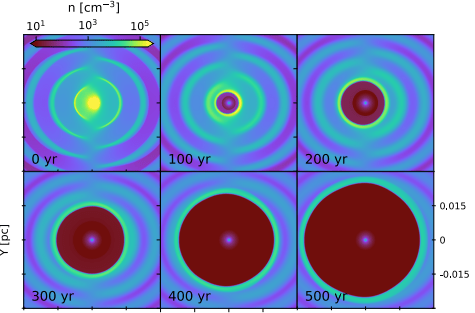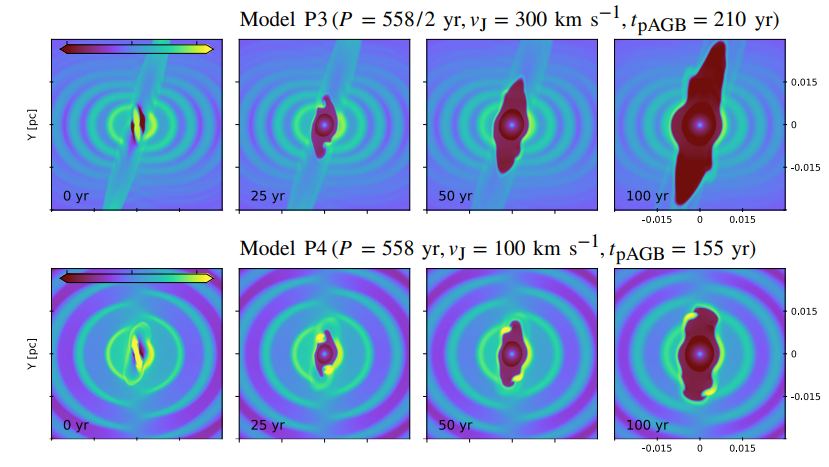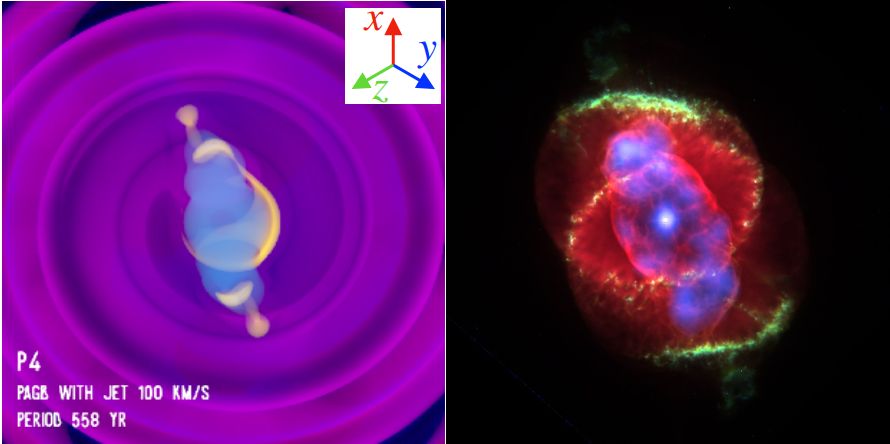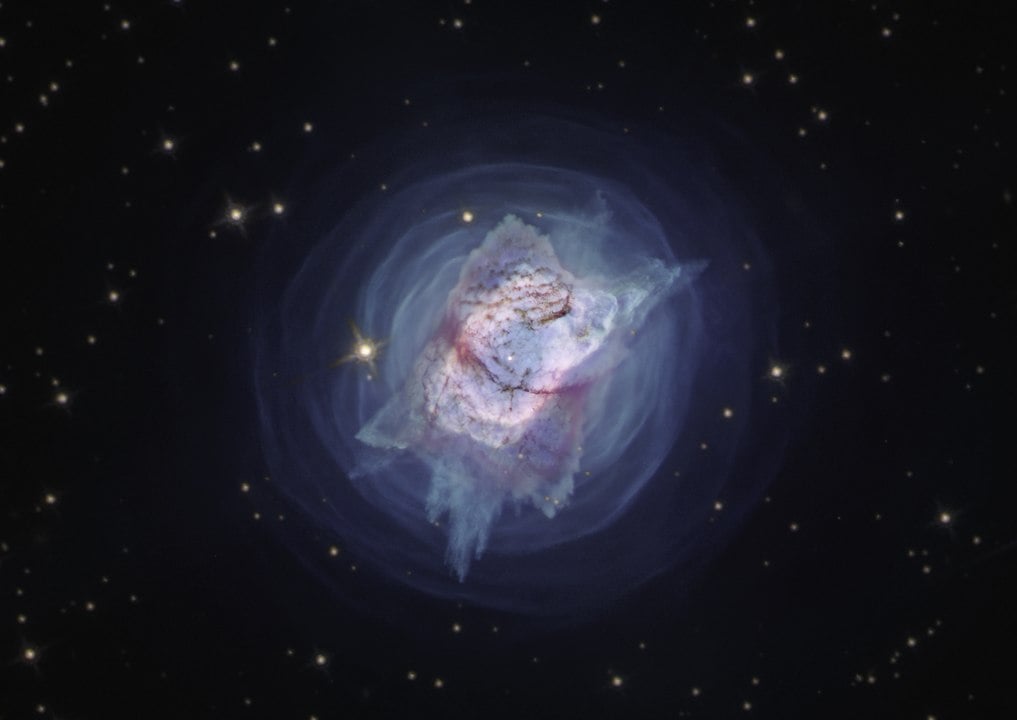When it comes to cosmic eye candy, planetary nebulae are at the top of the candy bowl. Like fingerprints—or maybe fireworks displays—each one is different. What factors are at work to make them so unique from one another?
Any discussion of planetary nebulae should start with a disclaimer. The colourful images we see on the web are not what they would look like to the human eye. But they're not fake, either. Since nebulae, unlike stars, shine only in narrow spectral lines, the images are processed so the colour is exaggerated, or maybe reconstructed is a better word. In astronomical images, colours are routinely applied to different chemicals, velocities, or other properties. The colours help illustrate the complexity of these objects in a way that would otherwise require paragraphs of complicated language. In any case, our limited human eyesight doesn't define the Universe. Our eyes evolved on Earth, so presenting images of objects in space, like planetary nebulae, requires some work.
But there's more to planetary nebulae than eye-catching colours. Their shapes are unique too, and they can tell us as much or more about nebulae than colours do. A new study examines some of the reasons their shapes are so different and how binary companions affect their shapes.
The study is " Emerging planetary nebulae within 3D spiral patterns. " The lead author is Verónica Lora from the Institute of Nuclear Science at the Universidad Nacional Autonoma de Mexico. Lora's co-authors are from Mexico and Spain.
Without getting lost in endless disclaimers, there's one other important one when it comes to planetary nebulae: they have nothing to do with planets. They were given that name before modern telescopes came along and allowed astronomers to see them clearly. To early astronomers, they looked kind of like planets, and that's how they got their name.
Planetary Nebulae (PNe) come from main-sequence stars that have become red giants. As the star reaches the end of its red giant stage, it sheds gases into space. Once the red giant ceases fusion, a white dwarf remains. The star's expelled gases absorb the ultraviolet radiation from the white dwarf, then emit it in different wavelengths. This is why a planetary nebula is an emission nebula rather than a reflection nebula.
Most stars in the Milky Way are not solitary; they have a binary companion. So when one of the stars becomes a planetary nebula, the binary companion can shape the nebula. The new research focuses on the effect that binary companions can have on nebulae. It also looks at the role that jets play.
The study looks at the 3D spiral patterns in a still-forming PNe that result from a companion in a circular orbit. Their results show that the companion's orbital period can have a powerful effect on the eventual shape of the nebula by affecting the spirals. Their results also show how jets from the white dwarf at the heart of the PNe can help erase the spirals and shape the object.
There's wide agreement that most PNes somehow form via the evolution of binary systems. That means that we should expect to find ring-like structures in their halos. Previous research suggested that about 35% of PNes should have these structures. But a 2016 study of 650 PNes showed only 8% of them have these structures. What happened to them?
"The variety of morphologies exhibited by PNe (round, elliptical, bipolar, multipolar and irregular; e.g.,) has been taken as evidence for the action of additional physical shaping mechanisms," the authors write. If only 8% of PNes exhibit ring-like structures, then something could be erasing them. "Such low occurrence of ring-like structures might suggest the existence of a physical mechanism erasing their signature," the researchers explain in their work.
The researchers wanted to understand how a binary companion's orbital period helps shape those spiral patterns and how they eventually shape the nebulae themselves. But there are hurdles to overcome: within only a few hundred years, the thermal expansion of the nebulae dilutes the spiral patterns, and jets ejecting material further dilute the patterns.
To clear those hurdles, the authors turned to one of astronomers' most powerful tools: simulations. In this case, they used 3D radiation-hydrodynamic simulations to probe the formation of PNe. "We present the first 3D radiation-hydrodynamic simulations of the formation of planetary nebulae (PNe) emerging from 3D spiral patterns," they write.
The critical period is the post-AGB phase. AGB stands for Asymptotic Giant Branch, so post-AGB basically means the period of time after a star has become a red giant and has expelled gases that form the PN.
Their simulations agree with previous research showing a low detection rate of rings and spirals. Their simulations also agree with previous results showing how a PN's spiral structure can disappear pretty quickly owing to dynamical effects from its binary companion. But they also simulated the effect of jets from the white dwarf inside the PNe and showed how they help erase the spiral and ring structures.
The simulated images are aligned with the shapes of PNes we see in telescope images. For example, the Cat's Eye Nebula, one of the most well-known and often-imaged nebulae, has a familiar similarity to one of the simulations in particular. "In particular, the image in the bottom left panel of Fig. 8, corresponding
to model P4, presents density enhancements (in yellow) indicative of the interactions between a precessing jet and the 3D spiral structure reminiscent of the bow-shock-like structures observed in NGC 6543," they write.
While some of the details of PNe processes are beyond complex simulations, the team did reach some conclusions.
The densest regions of the spirals disappear pretty quickly. In only about 500 years, thermal expansion erases them. Jets also help disrupt the spirals. For these reasons, the authors write, "Trying to assess orbital parameters from disrupted spirals, that is ring-like structures, in the halos of PNe should be taken with care, especially for those cases in which the structures have been heavily disrupted such is the case of NGC 7027."
The team's results also show the orbital period of the binary has consequences for the formation of the PNe, especially in the early stages. "In particular," they explain, "we show that more entwined 3D spirals produced with smaller orbital periods hinder the expansion of hot bubbles towards the orbital plane, allowing the expansion of elliptical cavities towards polar directions."
They also show how the presence of jets can shape the PNe. " exhibits the presence of bow-shock-like features produced by the interaction of the jets with the densest regions of the 3D spiral," they write, pointing out the previously mentioned Cat's Eye Nebula.
There's more work to do to understand how PNes form. A 2021 study showed how even very slow winds from the AGB star, and binary eccentricity, can cause the PNe to depart from a ring-shaped structure. The authors of this paper say that more work is needed to understand how all of this fits together to form irregularly-shaped PNe.
Everything in nature is complex, and the complexity deepens the more we study things. Maybe nothing in nature exemplifies this better than planetary nebulae can. Their fascinating visual complexity is of interest not only to astronomers but to anyone who wants to engage with nature.
More:
- New Research: Emerging planetary nebulae within 3D spiral patterns
- Older Research: Binary stars as the key to understanding planetary nebulae
- Universe Today: This Serpent’s Tail is Made of Starry Nebulae
 Universe Today
Universe Today





